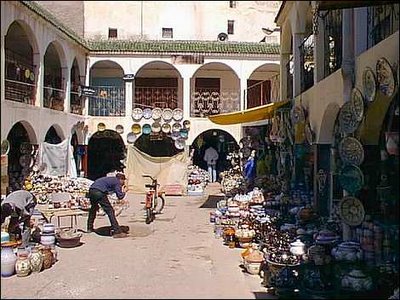When I think of Morocco, I think of beautiful multi-patterned blue tiles, ornate architecture, and pottery.Morocco's varied geology and rich mineral deposits make it one of the world's largest exporters of phosphates. They have also inspired the production of traditional ceramic tiles and pottery -- a craft industry which is still thriving today.
The potters' quarter is just outside of the city walls of Safi, Morocco. As strange as it might seem, life here goes on as always, even with several tour groups stopping by every day. All around this area, chimneys form large beehive-kilns.
"Fez is famous for the production of its typical blue pottery, known as Fakhari by the locals and Bleu de Fez by the French. Today, Fez is one of the most intriguing cities of the Islamic world, celebrated for its prolific output of hand-crafted items -- leather goods, woolen carpets, carved wood, and gold, brass and silver objects as well as pottery."
"The predominance of blue in the ceramics and pottery of the Fez region is originally due to the presence of cobalt in the rocks and stones swept down by rivers into the narrow gorge of Wadi Mellih. When ground, certain of these rocks produced beautiful coloured glazes, which were once much prized by the pottery industry. In recent years, however, the traditional and highly-skilled craft of selecting the cobalt-rich rocks has completely died out, and glazes are now imported from overseas, particularly from Germany."
Jim Miller's Images of Daily Life in Morocco is one of the first websites I found when I first started learning how to use a computer. More images of Moroccan markets are here, as well as images of the Berbers, Marrakech, and farming in the Atlas Mountains.
The potters' quarter is just outside of the city walls of Safi, Morocco. As strange as it might seem, life here goes on as always, even with several tour groups stopping by every day. All around this area, chimneys form large beehive-kilns.
"Fez is famous for the production of its typical blue pottery, known as Fakhari by the locals and Bleu de Fez by the French. Today, Fez is one of the most intriguing cities of the Islamic world, celebrated for its prolific output of hand-crafted items -- leather goods, woolen carpets, carved wood, and gold, brass and silver objects as well as pottery."
"The predominance of blue in the ceramics and pottery of the Fez region is originally due to the presence of cobalt in the rocks and stones swept down by rivers into the narrow gorge of Wadi Mellih. When ground, certain of these rocks produced beautiful coloured glazes, which were once much prized by the pottery industry. In recent years, however, the traditional and highly-skilled craft of selecting the cobalt-rich rocks has completely died out, and glazes are now imported from overseas, particularly from Germany."
Jim Miller's Images of Daily Life in Morocco is one of the first websites I found when I first started learning how to use a computer. More images of Moroccan markets are here, as well as images of the Berbers, Marrakech, and farming in the Atlas Mountains.
